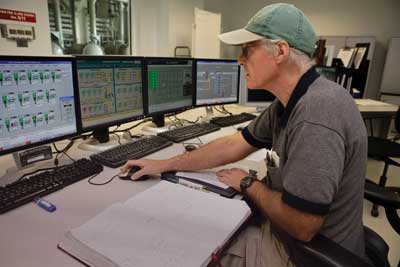 Combining financial measures with process control data in real time allows plant operators to directly influence and improve profitability, says Peter Martin, vice-president for innovation and marketing, process automation at Schneider Electric
Combining financial measures with process control data in real time allows plant operators to directly influence and improve profitability, says Peter Martin, vice-president for innovation and marketing, process automation at Schneider Electric
Industry has continually sought new and more effective ways to control manufacturing and production processes. As new technology has influenced factories and plants, new approaches have emerged to maximise benefits realised. One such idea is “profitable efficiency”, which is profitability control cascaded to process control to maximise operational profitability in real time.
The primary objective of process and logic control is to improve the efficiency of an operation. This has traditionally been measured by determining if throughput has increased while energy and material consumption have decreased. To improve efficiency, a feedback control loop measures the variables that need to be controlled, determines the variation from the desired set point and adjusts the variables to move toward the set point.
Since the 1960s, process control has advanced significantly beyond single-loop feedback control. For example, multi-loop cascade control, feedforward control, and coordinated multiple variable control use dynamic process models to make possible very sophisticated control strategies.
Fundamentally, real-time control involves making and acting on decisions in the period defined by the time constant of the process being controlled. In other words, the timing is defined by the process being controlled, rather than human time schedules such as daily, weekly or monthly. In this article, decisions being made on human schedules are referred to as management decisions, while decisions made on process schedules are referred to as control decisions.
Traditional control strategies can be categorised into four basic types. There are manual and automatic control strategies, as well as feedback and predictive strategies, which can use automatic or human control. When humans are provided with the information they need to make effective real-time control decisions and the tools they require to act on that information and to achieve a positive result, we say they are “empowered.” For a workforce to be empowered, operators must be provided with the tools necessary for them to effectively serve as controllers.
Energy price fluctuations
It used to be understood that any improvements in efficiency could be translated directly into improvements in operational profitability. But this is no longer the case. Since the early 2000s, the speed of industrial business has steadily increased, triggered by the deregulation of electric power. As electrical power was deregulated, the supply-to-demand ratio on the grids started to fluctuate.
Energy suppliers and grid managers tried to deal with these fluctuations by increasing the price of energy when demand was high and supply was low and reducing the price of energy when demand was low and supply was high.
This pricing variation threatened to create turmoil among energy consumers, causing governments to regulate the pricing periods. For example, in the US, the price of energy can only change every 15 minutes, while in the UK it can change every 20 minutes.

This still meant that electricity consumers such as industrial plants might decrease their energy consumption but their energy bill could increase if they consumed more electricity during the higher price periods.
The fluctuations in electricity prices caused a domino effect across other energy sources and raw materials. To try to deal with the unstable costs, industrial companies started changing the price of their products more frequently. This effect is most easily seen in energy markets, but it affects consumer production as well.
Today, in an increasingly speedy industrial market, not only must plant managers decide how much to produce, but operators must also decide the best time to produce. This can sometimes diminish the importance of operational efficiency: it might be more profitable to run the plant less efficiently, according to the traditional efficiency measures, to meet market demand and opportunity more cost-effectively.
As a result, process control for improved operational efficiency no longer had as direct an impact on improved operational profitability. Traditional process control was necessary, but not sufficient. New approaches were required to deal with the ever-increasing real-time dynamics of industrial business variables. Executives struggled with how to address this issue for years, and were often heard remarking that their processes were under control while their profitability was out of control.
The first response of industry was to turn to IT departments and enterprise resource planning suppliers for solutions. Few, if any, achieved the desired results, primarily because the IT teams and ERP software suppliers were both experienced in solving traditional management problems, but not real-time control problems.
Real-time profit control
The solution involved understanding that as operational profitability fluctuated faster and faster, management decisions had become control decisions. In other words, the solution had to be approached from the perspective of real-time control.
Real-time control is predicated on the availability of real-time measurements. The first problem to be addressed was measuring operational profitability in real time.
Engineers developed new performance indicators with monetary context to try to solve this problem, but these had little credibility with the cost accounting teams who actually measure the performance of operations because they used different measures.
The successful approach involves calculating the accounting factors of the operation in real time. This means having a real-time of view how efficiently each aspect of the process is working, both in cost and function. This gives engineers the ability to find where profits are being lost.
It can be done by combining and cross-referencing sensor-based data from any part of the process with financial data, such as fluctuating energy costs or the cost of a commodity-based raw material, in real time. This is referred to as real-time accounting (RTA).
Once RTA factors became available, they could be used to control operational profitability dynamically. Providing real-time feedback to operators so they can see the financial impact of their actions empowers them to learn how to operate the process most profitably. The result is manual real-time profit control. As engineers gain more insight into the factors that drive the decisions made by operators, automated control will eventually be developed.
Cascading profit control to process control
The next challenge was determining the relationship between traditional process control and real-time profitability control. Clearly, operational profitability cannot be manipulated if the efficiency of a plant is not well controlled. In fact, there is a classic control relationship between profitability control and efficiency control. It involves a cascade control strategy with profitability control as the primary loop, cascading set points to process control, serving as the secondary loops.
Implementing profit control strategies over process control strategies results in a new class of real-time control strategies, referred to as “profitable efficiency”. Implementing profitable efficiency throughout an industrial operation tends to drive new and improved levels of operational profitability that can achieve 100% return on investment in a very short time, often under six months, with sustainable results that last and improve for years.
Making the real-time accounting measures the primary performance indicators of industrial operations guarantees their sustainability and often makes possible continual operational profitability improvements for the life of the plant. Additionally, embedding the RTA models throughout the operation enables managers to measure operational profitability for any initiative that affects the performance of the operations. With these measures, managers can learn how to shift focus of their resources to activities that create more value.
Conclusion
The field of real-time control is expanding from traditional process and logic control to other real-time domains, such as operational profitability. As new control strategies are applied to new domains, the performance of industrial operations will improve significantly, to levels never before expected.
Profitable efficiency, by linking process control to profitability control, represents one new approach. It has been proved to drive strong results because it allows you to keep both your process and profits in control.
https://www.schneider-electric.com/en/work/solutions/software/by-industry/

